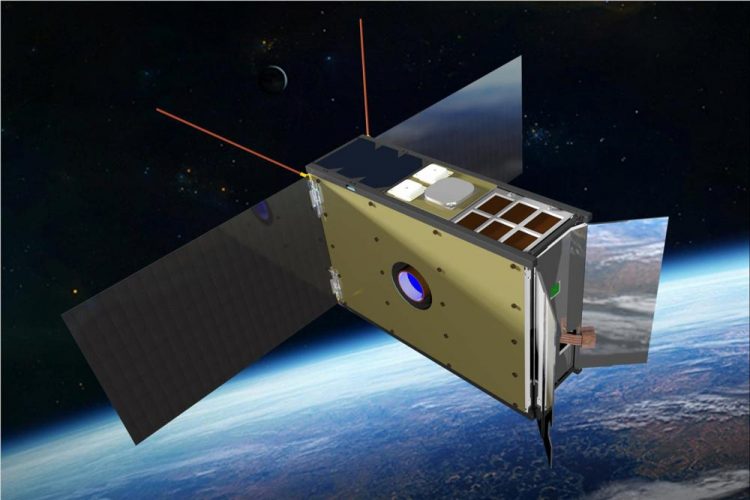University of Melbourne to build and launch innovative satellite

Australian-made spacecraft to host a foreign space agency payload, with an X-ray detector provided by the Italian Space Agency. Credit: University of Melbourne Usage Restrictions: Pic to be only associated with story of Uni Melb researchers
Science and engineering researchers at the University of Melbourne have been awarded a $3.95 million Australian Government grant to help develop cutting edge space capabilities in Australia.
The funding from the International Space Investment Expand Capability Program will allow researchers to build a small satellite – called SpIRIT – to be launched in space by 2022, in collaboration with multiple Australian space industry companies and the Italian Space Agency.
Associate Professor Michele Trenti from the University's School of Physics is the lead investigator of the Space Industry Responsive Intelligent Thermal (SpIRIT) satellite.
“SpIRIT will be very small – about the size of a shoe box – but powerful,” Associate Professor Trenti said. “It will carry innovative X-ray sensors, sophisticated on-board computers and radios, and even a miniaturised electric propulsion engine, so we could well say that we will be building a tiny robotic spaceship.
“It will be the first Australian-made spacecraft to host a foreign space agency payload, with an X-ray detector provided by the Italian Space Agency.”
Associate Professor Trenti said SpIRIT will demonstrate that Australian-made spacecraft are internationally competitive, opening new market opportunities.
“SpIRIT will not only benefit Australian industry, it will also contribute to some awesome scientific discoveries,” Associate Professor Trenti said. “In particular, SpIRIT will combine its X-ray observations with data from a constellation of six other European satellites to spot cosmic fireworks that can be produced when stars die or collide with each other.”
The SpIRIT mission will demonstrate innovative technological elements in the areas of thermal management, real-time communications and on-board autonomous decision capabilities that University of Melbourne researchers will use in future space telescope projects for both Earth and astronomical observations.
SpIRIT is a partnership between the University of Melbourne's Physics and Engineering Schools, Sitael Australia, Inovor Technologies, Neumann Space, and Nova Systems, with support from the Italian and United Kingdom Space Agencies (UK in an advisory role).
Dr Airlie Chapman, senior lecturer in mechatronics from Melbourne School of Engineering and co-investigator on the project, said SpIRIT will increase Australia's reputation in the global space sector, and contribute to training a highly capable future workforce.
“Building an innovative space-ready nanosatellite comes with unique challenges,” Dr Chapman said. “This project will help us apply engineering research to break new ground in nanosatellite design, manufacturing and operations, hopefully acting as a guide for Australian aerospace research in the future.”
Postgraduate students will have the opportunity to join engineering teams at the University of Melbourne and at industry partners through a paid internship program designed to mentor and inspire future space leaders, concluded Dr Chapman.
Deputy Vice Chancellor (Research) Professor Jim McCluskey has welcomed the grant saying it acknowledges the work of the University to support Australia's space capabilities endeavours.
“SpIRIT is an important partnership that reflects the creativity, relevance and excellence of our researchers. The program will generate wider benefit for Australian businesses, and the next generation of space workforce, researchers and entrepreneurs. This is an outstanding achievement,” Professor McCluskey said.
Media Contact
All latest news from the category: Physics and Astronomy
This area deals with the fundamental laws and building blocks of nature and how they interact, the properties and the behavior of matter, and research into space and time and their structures.
innovations-report provides in-depth reports and articles on subjects such as astrophysics, laser technologies, nuclear, quantum, particle and solid-state physics, nanotechnologies, planetary research and findings (Mars, Venus) and developments related to the Hubble Telescope.
Newest articles

Future AR/VR controllers could be the palm of your hand
Carnegie Mellon University’s EgoTouch creates simple interfaces for virtual and augmented reality. The new generation of augmented and virtual reality controllers may not just fit in the palm of your…

‘Game changer’ in lithium extraction
Rice researchers develop novel electrochemical reactor. A team of Rice University researchers led by Lisa Biswal and Haotian Wang has developed an innovative electrochemical reactor to extract lithium from natural…

The blue-green sustainable proteins of seaweed
… may soon be on your plate. The protein in sea lettuce, a type of seaweed, is a promising complement to both meat and other current alternative protein sources. Seaweed…



